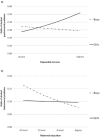Early life socio-economic position and later alcohol use: birth cohort study
- PMID: 23164048
- PMCID: PMC4150526
- DOI: 10.1111/add.12018
Early life socio-economic position and later alcohol use: birth cohort study
Abstract
Aims: To investigate associations between socio-economic position in early life and later alcohol use and problem use among male and female adolescents.
Design: Birth cohort study.
Setting: South West England.
Participants: A total of 2711 girls and 2379 boys with one or more measures of alcohol use or problem use at age 15 years.
Measurements: Exposure measures were highest parental social class, maternal education and household disposable income (all maternal self-report before school-age); outcome measures were heavy typical drinking, frequent drinking, regular binge drinking, alcohol-related psychosocial problems and alcohol-related behavioural problems.
Findings: Alcohol use and related problems were relatively common amongst adolescent girls and boys. Boys were slightly more likely to report frequent drinking and girls were slightly more likely to drink heavily and to experience alcohol-related psychosocial problems. Higher maternal education appeared protective in relation to alcohol-related problems, particularly among boys. Higher household income was associated with greater risk of alcohol use and problem use, most apparently among girls.
Conclusions: Children from higher-income households in England appear to be at greater risk of some types of adolescent alcohol problems, and these risks appear different in girls compared to boys. Childhood social advantage may not generally be associated with healthier behaviour in adolescence.
© 2012 The Authors, Addiction © 2012 Society for the Study of Addiction.
Figures

Similar articles
-
Adolescent alcohol and tobacco use and early socioeconomic position: the ALSPAC birth cohort.Pediatrics. 2011 Apr;127(4):e948-55. doi: 10.1542/peds.2009-3450. Epub 2011 Mar 14. Pediatrics. 2011. PMID: 21402626
-
The contribution of alcohol use and other behavioural, material and social factors to socio-economic differences in alcohol-related disorders in a Swedish cohort.Addiction. 2017 Nov;112(11):1920-1930. doi: 10.1111/add.13889. Epub 2017 Jul 17. Addiction. 2017. PMID: 28556302
-
Adverse adult consequences of different alcohol use patterns in adolescence: an integrative analysis of data to age 30 years from four Australasian cohorts.Addiction. 2018 Oct;113(10):1811-1825. doi: 10.1111/add.14263. Epub 2018 Jun 19. Addiction. 2018. PMID: 29749666
-
Adolescent smoking and tertiary education: opposing pathways linking socio-economic background to alcohol consumption.Addiction. 2016 Aug;111(8):1457-65. doi: 10.1111/add.13365. Epub 2016 May 9. Addiction. 2016. PMID: 27162105 Free PMC article.
-
Adolescent income and binge drinking initiation: prospective evidence from the MyLife study.Addiction. 2021 Jun;116(6):1389-1398. doi: 10.1111/add.15279. Epub 2020 Oct 29. Addiction. 2021. PMID: 33009694
Cited by
-
Social Inequalities in Harmful Drinking and Alcohol-Related Problems Among Swedish Adolescents.Alcohol Alcohol. 2019 Jan 9;54(5):532-539. doi: 10.1093/alcalc/agz044. Alcohol Alcohol. 2019. PMID: 31206150 Free PMC article.
-
Conduct problem trajectories and alcohol use and misuse in mid to late adolescence.Drug Alcohol Depend. 2013 Nov 1;133(1):100-7. doi: 10.1016/j.drugalcdep.2013.05.025. Epub 2013 Jun 17. Drug Alcohol Depend. 2013. PMID: 23787037 Free PMC article.
-
Gender differences in the prospective association between maternal alcohol consumption trajectories and young adult offspring's problem gambling at 30 years.Asian J Gambl Issues Public Health. 2016;6(1):2. doi: 10.1186/s40405-016-0010-3. Epub 2016 Apr 8. Asian J Gambl Issues Public Health. 2016. PMID: 27630809 Free PMC article.
-
Developmental Pathways from Parental Socioeconomic Status to Adolescent Substance Use: Alternative and Complementary Reinforcement.J Youth Adolesc. 2018 Feb;47(2):334-348. doi: 10.1007/s10964-017-0790-5. Epub 2017 Nov 30. J Youth Adolesc. 2018. PMID: 29188410 Free PMC article.
-
Inconsistency in reporting abstention and heavy drinking frequency: associations with sex and socioeconomic status, and potential impacts.Alcohol Alcohol. 2015 May;50(3):333-45. doi: 10.1093/alcalc/agu106. Epub 2015 Feb 3. Alcohol Alcohol. 2015. PMID: 25648932 Free PMC article.
References
-
- US Department of Health and Human Services. 2007. The Surgeon General's Call to Action to Prevent and Reduce Underage Drinking. Rockville, MD (US): Department of Health and Human Services, Office of the Surgeon General (US) - PubMed
-
- Hibell BR, Guttormsson U, Ahlström S, Balakireva O, Bjarnason T, Kokkevi A, et al. The 2007 ESPAD Report: Substance Use Among Students in 35 European Countries. Stockholm, Sweden: The Swedish Council for Information on Alcohol and other Drugs (CAN); 2009.
-
- Johnston LD, O'Malley PM, Bachman JG, Schulenberg JE. Monitoring the Future National Results on Adolescent Drug Use: Overview of Key Findings, 2008. Bethesda, MD: National Institute on Drug Abuse; 2009.
-
- Nutt DJ, King LA, Phillips LD. Drug harms in the UK: a multicriteria decision analysis. Lancet. 2010;376:1558–1565. - PubMed
-
- Hingson RW, Heeren T, Winter MR. Age at drinking onset and alcohol dependence—age at onset, duration, and severity. Arch Pediatr Adolesc Med. 2006;160:739–746. - PubMed
Publication types
MeSH terms
Grants and funding
LinkOut - more resources
Full Text Sources
Medical

